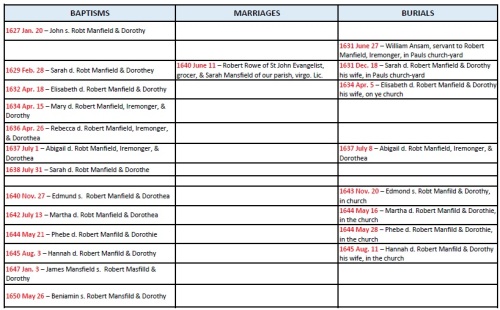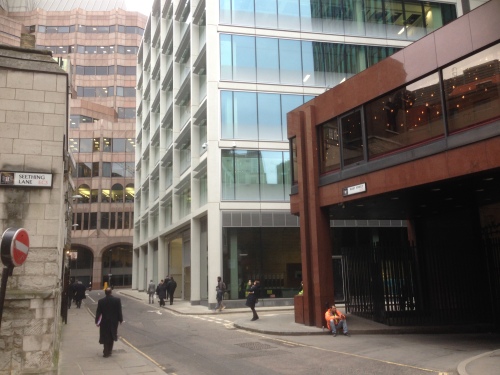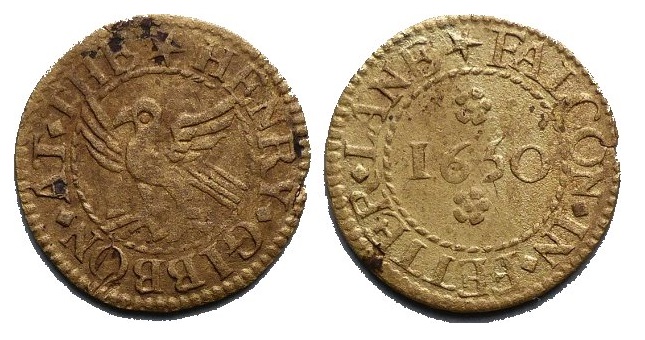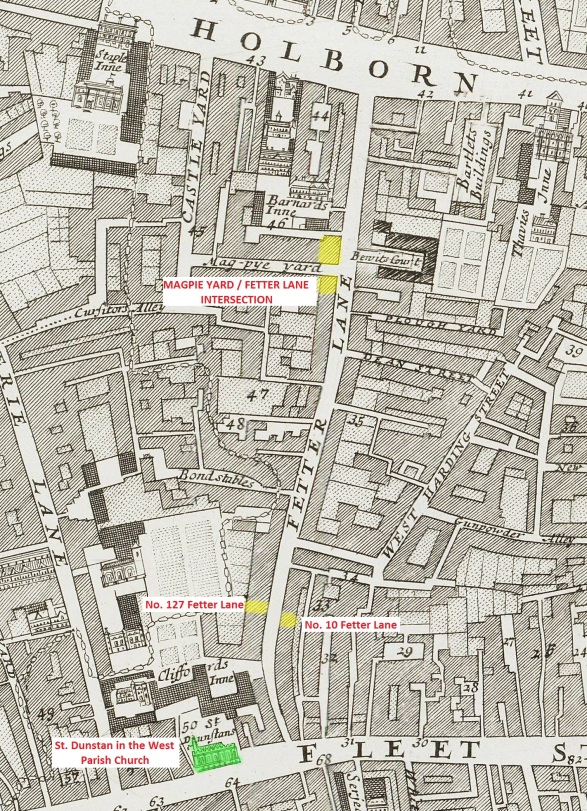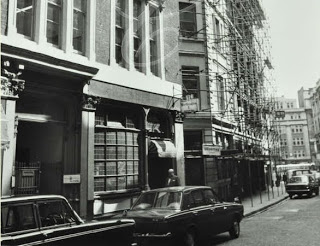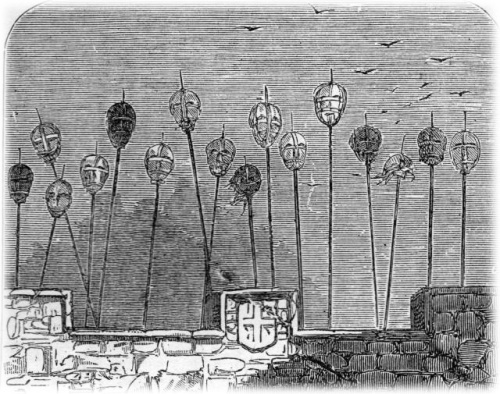The above mid-17th century copper farthing token measures 15.4 mm and weighs 0.96 grams. It was issued by Anthony Joyce between late 1666 and early 1668. At the time of the token’s issue, Anthony was the landlord of The Three Stags inn which was located close to Holborn Conduit in the London Ward of Farringdon Without.
The design of the token is outlined below;
Obverse: (mullet) ANTHONEY . IOYCE . around a twisted wire inner circle containing three stags.
Reverse: (mullet) AT . HOBORN . CONDED , around a twisted wire inner circle. A triad of initials (representing those of the token issuer and his wife) within reads, .I. above A.K
Holborn Conduit was one of London’s ancient water supply systems. It was built in 1498 to direct and dispense the flow of clean water from the Fleet River to the local population of Holborn. The location of the Conduit can be clearly seen in the Agas Map of London of c.1561. Its structure is also visible on the early 18th century map below in the centre of the road junction joining Holborn Bridge, Snow Hill, Cow Lane and Cock Lane.

A map of Holborn (c.1720) showing the locations of Holborn Conduit (in yellow) the parish churches of St. Andrew’s (in blue) and St. Sepulchre’s (in red).
The Token Issuer & His Family
For a significant amount of the known background and family history details of this token issuer, we owe much to the famous diarist Samuel Pepys. Anthony Joyce, and his brother William, were married to Pepys’ nieces, Katherine (Kate) and Mary Fenner respectively (Note 1). Pepys mentions Anthony Joyce over 57 times throughout his diary entries which span the period 1660 to 1669. Despite the family ties, it is clear from his journal entries that Pepys regarded the Joyce family as some of the least congenial of his relatives.
Anthony Joyce was the son of William Joyce, a leather seller and citizen of London. From at least 1641 (Note 2) William lived in Holborn within the parish of St. Sepulchre. In 1654 he is recorded as holding the office of Third Warden of the Leather Seller’s Company (1). Despite this, he is also practised as a tallow chandler. While both of William’s sons were made freemen of the Leather Seller Company, by patrimony in 1654 (2), they both followed in their father’s footsteps by becoming tallow chandlers. William operated in the west of London while Anthony is thought to have taken up shop in the Parish of St. Giles without Cripplegate in the north-western area of the city (Note 3).
It is unclear exactly when Anthony married Kate Fenner or how many children they had. In his diary, Pepys mentions the death of Anthony’s “only child” on 1st January 1660/1 although by inference from his Last Will and Testimony (made in January 1667/8) (3) the couple had other children of which three survived Anthony’s death (4).
It appears that Anthony made a satisfactory living as a chandler. On one occasion we know that Pepys ventured into a scheme with him whereby the latter would sell him candles at a very attractive rate to supply the Royal Court. The significant profit margin on the re-sale of the candles would represent a handsome profit to Pepys while Anthony would win a prestigious and hopefully long-term supply contract. It is clear from one of Pepys’ diary entries from Autumn of 1661 that Anthony supplied him with at least an initial batch of candles for the Court. To Pepys’ annoyance, Anthony requested the early payment for these. It is unclear if their proposed project continued any further.
By mid-December 1664 Anthony had made the decision to quit the tallow trade and move into new lodgings. The reasons for this are not fully clear and it is unknown how he continued to make his immediate living after this time. He may have become more involved with the leather trade and/or lived off the rents from the several houses we know he owned (Note 4) across London. It certainly appears that his income at this time remained essential to him remaining in the city as throughout the worst devastations of the infamous plague of 1665 both he and his wife remained in the city and did not flee to the relative safety of the country as did so many other Londoners of means. It was only after some considerable persuasion in late July of 1665, from his cousin Pepys’, that Anthony finally agreed to let his wife move out of their home and stay with friends in the safer country environs of Windsor where she likely stayed until the plague had died down sufficiently, in late 1665, for her to safely return to London.
By mid-January 1665/6 Anthony’s work situation had not changed and it is clear from a reference in Pepys diaries that his wife Kate was concerned as she disclosed that their family had lost £140 since Anthony gave up his tallow business over a year earlier. The same diary entry notes that Pepys thought Anthony’s decision to leave his trade was unwise and on the character of his cousin he derogatorily notes “for he is a man will not know how to live idle, and employment he is fit for none”.
Anthony and Kate’s fortunes took a further blow on 5th September 1666. It was the fourth day of the Great Fire of London, and in his diary, Pepys’ noted that while on his way home in the evening he passed between Cheapside and Newgate Market where he saw the burnt remains of the Joyce’s home. Several days later (14th September), in a further diary entry, Pepys records how Kate Joyce visited him and told how she and her husband had lost a considerable rental income (£140 per year) through the loss of properties they owned across the city which had been consumed by the Great Fire. Fortunately, they still had seven of their rented houses left on which to draw an income. This was further confirmed to Pepys when on 22nd September a tearful Anthony Joyce told him much the same story but added that he and Kate had a plan to move to a new property in the parish of St. John’s, Clerkenwell where he again might resume his old trade. Whether or not the Joyces made the proposed move to Clerkenwell is unknown but in a further of Pepys diary entries he recounts how Anthony and Kate dined with him on 3rd December 1666 and explained how they had taken on the running of an Inn (i.e. The Three Staggs at Holborn Conduit – Note 5). However, it appears that the couple had already become weary of this new business venture and were looking to do something different asking Pepys if he could assist them in finding Anthony a new position. In commenting on this request Pepys notes “but I know none the foole is fit for”. The same diary entry further notes how Anthony and Kates’s combined property losses, due to the Great Fire, amounted to £3,000 but that they still had sufficient income to live on. Despite this, the couple must have been under considerable financial pressure and stress through the combined effects of Anthony giving up his tallow business plus the loss of several properties and their associated rental incomes. Conversely, Anthony’s brother, William, prospered as a direct result of the Great Fire. His tallow business was based in the far west of the city, in an area largely untouched by the inferno. As such his trade increased due to the dearth of competition.
On 22nd December 1666, Pepys notes that Kate Joyce visited him and on the basis of asking for a loan of £300 so that Anthony could rebuild his house. Pepys appears to have agreed as long as sufficient securities for the loan could be put forward by the Joyces. The request for a loan is again noted in Pepys’ diary when on 5th January 1667/8 Anthony met with him and asked for an increased loan of £350 in order for him to rebuild his house. Pepys again confirmed his willingness to help his cousins and that he was offered good security against the loan. The two parted with Pepys being left with the charge of organising the loan. A few days later (9th January 1667/8) Pepys visited Anthony and confirmed that while he was still willing to lend him the funds previously requested, he could do so only on the basis that it would be on a short-term basis. The two parted with the arrangement of the loan still to be put in place. Pepys appeared to have done no more on the issue when on Tuesday 21st January he received urgent news at his office from his cousin Kate. She stated that if he wished to see her husband while he was still alive, he must come to their home as soon as possible. After completing work in his office Pepys and his assistant William Hewer went to the Joyce’s home at the Three Stags Inn near Holborn Conduit. Pepys stated in his diary entry that this was the first time he had visited them at their inn.
On his arrival the grave situation was explained to Pepys as he later records in his diary entry of the same day:
“…it seems on Thursday last he (i.e. Anthony) went sober and quiet out of doors in the morning to Islington, and behind one of the inns, the White Lion, did fling himself into a pond, was spied by a poor woman and got out by some people binding up hay in a barn there, and set on his head and got to life, and known by a woman coming that way; and so his wife and friends sent for. He confessed his doing the thing, being led by the Devil; and do declare his reason to be, his trouble that he found in having forgot to serve God as he ought, since he come to this new employment: and I believe that, and the sense of his great loss by the fire, did bring him to it, and so everybody concludes. He stayed there all that night, and come home by coach next morning, and there grew sick, and worse and worse to this day.”
Pepys found Anthony in bed with a fever. While gravely ill he was still conscious and lucid. He thanked Pepys for his kindness he had shown to him. Pepys further describes how Anthony’s breath later began to “rattle” in his throat and that while he was in the house those in attendance at his bedside laid pigeons at his feet in a desperate last attempt of effecting a cure (Note 6). By this time most of those in the house feared the worst and Anthony dictate his Last Will and Testimony (5) in which he left his entire estate to his wife Kate on the condition that she take care of their children (Notes 7). Pepys left the house prior to Anthony’s passing which is assumed to have occurred later that day. By the time Pepys’ left the inn it was clear to several there, including Kate Joyce, that the nature of events leading up to Anthony’s anticipated death could overturn the provisions of his Will as the then law dictated that the estates of suicide victims be turned over to the State. In anticipation of this, just prior to Pepys’ leaving their home, Kate Joyce handed him their household silver plate and flagons before they could be later listed as part of her husband’s estate and hence possibly later confiscated.
Anthony must have died shortly after Pepys’ visit that same day. Although the diarist makes no mention of it in his journal he appears to have taken immediate action on behalf of his cousin Kate to secure Anthony’s estate on behalf of her and her children. The very same day Pepys must have petitioned the King to agree that Anthony’s death was not the result of suicide but of fever. The outcome of Pepys’s meeting with the king is recorded in a State Paper(6) dated 21st January 1667/8 which notes the following;
Samuel Pepys to Joseph Williamson (Secretary of State) – “I am ordered by the King to desire you to prevent the issuing of any warrant for gaining the estate of Anthony Joyce, innkeeper, a supposed felo-de-se, away from his widow and three children”.
While Pepys’s kind and quick thinking may have initially protected Kate and her children’s inheritance it appears that the ultimate ruling on the cause of Anthony’s death and hence the proving of his Will would be subject to a public inquest. This appears to have been due to a quirk of the law, regarding the Joyces’ home address in the city, i.e. as living in a liberty under the jurisdiction of the Dean of St. Paul’s Cathedral and not the King. As such the king’s earlier ruling, preventing the seizure of Anthony’s estate, was legally invalid requiring a formal inquest and ruling on the cause of Anthony’s death before his Will could be proven.
Anthony Joyce’s funeral took place on 24th January 1667/8 and is recorded in a further of Pepys’s diary entries. The diarist notes that on that day he went to the Quest House (Note 8) in Holborn where he met with “a very great rabble of four or five hundred people of mean condition” who had gathered to start the funeral procession. From here the mourners moved off first to St Andrew’s Parish Church, Holborn, where a funeral service was held by the eminent Dr. Edward Stillingfleet (Note 9) who happened to be the incumbent parish vicar. Anthony’s “death” entry in the parish registers of Andrew’s Church records him as an Inn Keeper and his death due to a “surfeit” (i.e. an excess of something, typically food or drink). However, in his sermon, Dr. Stillingfleet referred to the cause of Anthony’s death as suicide. This was greatly upsetting to Kate Joyce and potentially jeopardised the ruling as to the final inquest as to the execution of Anthony’s Will. Any proof of his death as being the direct result of suicide would favour the confiscation of his estate by the State. After the service held at St. Andrew’s Church, many of the mourners (Pepys excluded) moved off in procession with the corpse to the nearby parish church of St. Sepulchre, Holborn. Her Anthony’s body was interred in the churchyard along with other past members of the Joyce and Fenner family.
The inquest into Anthony Joyce’s death, and hence the subsequent proving of his Will, continued after his funeral. On 4th February 1667/8 Pepys recorded the following on the subject in his diary entry;
“After dinner I abroad by coach to Kate Joyce’s, where the jury did sit where they did before, about her husband’s death, and their verdict put off for fourteen days longer, at the suit of somebody, under pretence of the King; but it is only to get money out of her to compound the matter. But the truth is, something they will make out of Stillingfleete’s sermon, which may trouble us, he declaring, like a fool, in his pulpit, that he did confess that his losses in the world did make him do what he did. This do vex me to see how foolish our Protestant Divines are, while the Papists do make it the duty of Confessor to be secret, or else nobody would confess their sins to them. All being put off for to-day, I took my leave of Kate, who is mightily troubled at it for her estate sake, not for her husband; for her sorrow for that, I perceive, is all over.”
Despite Dr. Stillingfleet’s unfortunate funeral sermon comments on the circumstances of Anthony death the Jury presiding over his inquest eventually return a verdict (on 18th February 1667/8) of death by fever. This was good news for Kate and her children as it legally secured their inheritance. According to Pepys diary entry for the above date, there was a degree of opposition during the final proceedings of the inquest as the jury’s foreman pressed for a reason for Anthony’s fatal fever. However, none was given, and the verdict was delivered as noted above.
In the immediate months following Anthony’s death, Kate Joyce continued to run the Three Stags Inn on her own. On 19th March 1667/8 Pepys’s notes in his diary that he received an anonymous letter advising him that as a young, attractive, and comparatively wealthy widow his cousin Kate was now receiving the attention of certain “unsavoury” potential admirers. Being concerned for her future wellbeing Pepys arranged to discuss this issue with her a few days later over diner at his home in Seething Lane. Kate explained that she had indeed had several offers of marriage since becoming a widow but that most of these were from “poor men” who she thought were not appropriate and whom she had no interest in. However, there was one suitor that she believed was very suitable, a tobacconist by the name of Holinshed. She asked her cousin if he could find out more about him and see if he thought he would make a suitable match for her. Pepys agreed to this request thinking that a suitable re-marriage would be good for Kate and would facilitate a means by which she could escape from her innkeeping business which he thought was unsuitable for her. Kate promised not to make any decisions on Mr. Holinshed’s proposal until her cousin had looked into him further. However, only a couple of weeks later, on the 11th May 1668, Pepys records to his annoyance in his journal that despite Kate’s earlier promise to allow him to properly “vet” Mr. Holinshed before she took things any further she had married him that very day. Pepys felt Kate had made too rash a decision in re-marrying without taking his further advice and records his last diary entry on the matter as being “as she brews, let her bake”.
Notes:
- Katherine was the daughter of one of Pepys mother’s sisters, Katherine Kite (died 1661) who married Thomas Fenner (died 1664) in 1633. The couple had two daughters, Katherine and Mary who subsequently married two brothers Anthony and William Joyce respectively.
- William Joyce (senior) is recorded in Poll Tax records as residing in Holborn in 1641(7). He died in 1658 and was buried in the parish church of St. Sepulchre, Holborn (8).
- Anthony’s Will officially records him as a being “late of the Parish of St. Giles without Cripplegate (and) Citizen and Leather seller of London” although at the time of the Great Fire Pepys notes his home as being between Cheapside and Newgate Market, close to St. Paul’s Cathedral.
- It is clear from the entry in Pepy’s Diary for 14th September 1666 that even after the events of the Great Fire Anthony Joyce still owned several houses in the city on which he continued to collect rents. How he came by these properties is unclear, but it is possible that some of them came as the result of inheritances (either directly to him or his wife Kate) after the deaths of his father and father-in-law (Thomas Fenner) in 1658 and 1664 respectively.
- The entry in Pepys diary for 6th December 1666 notes how William Joyce ridiculed his brother and sister in-law for taking on the Three Stags Inn calling them “hosteller and his sister hostess”.
- During the 17th century “pigeon cure” was often considered popular as a last-resort remedy for the dying. It entailed the laying of freshly killed pigeons at the feet of the patient in the belief that they would extract the fever and remedy a cure.
- The preparation of Anthony’s Will may have taken place before the time of Pepys’ arrival at the inn as he was not listed as one of its witnesses which would otherwise have been expected given his relatively high standing.
- A Quest House was a place where mourners met at the start of a funeral and at which inquests in a ward or parish were commonly held.
- Edward Stillingfleet (1635 to 1699) was a theologian and scholar. He was considered an outstanding preacher as well as a strong polemical writer defending Anglicanism. He was known as “the beauty of holiness” for his good looks in the pulpit. In 1665 he became vicar at St Andrew, Holborn. He notably preached at St. Margaret’s Church, Westminster on 10th October 1666, the “day of humiliation and fasting” after the Great Fire of London. This sermon gathered such an attendance that there was standing room only. Samuel Pepys recorded that he could not get in to hear the sermon, eating a meal of herrings in a tavern instead. Stillingfleet later became a Royal Chaplain and the Dean of St Paul’s Cathedral (1678) during which time he was greatly involved in its re-building. He was a frequent speaker in the House of Lords and had considerable influence as a churchman.
References:
- Latham, R.C. & Mathews, W. The Diary Samuel Pepys. Volume X. Companion. 1995. Harper Collins. London.
- Ibid 1.
- PROB 11/326/264 – Will of Anthony Joyce (19th February 1667/8), National Archives, London.
- Whittear, W.H. More Pepysiana. 1927. Simpkin, Marshall, Hamilton, Kent & Co. London.
- Ibid 3.
- Ibid 4.
- Boyd, P. – Inhabitants of London. A genealogical Index held by the Society of Genealogists, London.
- Ibid 7.
Acknowledgements:
- Acknowledgement is given to Galata for their kind provision of the image of the token used to illustrate this article.














